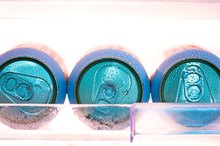Allergy to Yellow Dye
Yellow food dye can cause mild to severe allergic reactions if you have a sensitivity to one or more chemical components in the product. Manufacturers use this synthetic dye, referred to as FD&C Yellow No 2. 5 or tartrazine, in many food products, and you will need to read ingredient lists carefully to determine which processed foods contain this additive. If you suspect an allergy, know the symptoms and common food sources to help you prevent complications 1.
If you are experiencing serious medical symptoms, seek emergency treatment immediately.
Allergic Reaction Symptoms
Common allergic reactions to products such as:
- yellow dye include hives
- skin itching
- stomach pain
- nausea
- vomiting
- diarrhea
A severe reaction may result in swelling of your lips and tongue, as well as difficulty swallowing or breathing. You may also experience chest pain. If you experience these or any other symptoms, contact your doctor immediately. For chest pains and difficulty breathing, seek immediate emergency medical attention. If you have a severe allergic reaction, your doctor may prescribe epinephrine for you to keep on hand at all times. This injectable medication will typically reduce swelling and other severe symptoms immediately. You will still need to seek medical attention to ensure management of your symptoms.
- Common allergic reactions to products such as: * yellow dye include hives
* skin itching
* stomach pain
* nausea
* vomiting
* diarrhea A severe reaction may result in swelling of your lips and tongue, as well as difficulty swallowing or breathing. - For chest pains and difficulty breathing, seek immediate emergency medical attention.
Asthma-Induced Reactions
Allergy to Red Dye in Drinks
Learn More
Early studies of tartrazine in the 1950s linked yellow dye to the occurrence of asthmatic episodes. The studies were anecdote- and observation-based, which may not have provided the most accurate data, according to the University of Nebraska-Lincoln. More recent studies cannot confirm these early findings. If you experience asthma attacks that you believe stem from the consumption of yellow dye products, however, talk with your doctor to determine appropriate treatment.
- Early studies of tartrazine in the 1950s linked yellow dye to the occurrence of asthmatic episodes.
Additional Health Concerns
Yellow food dye may be linked to a number of conditions that could inhibit learning and other cognitive functions in children. Potential concerns include an increase in hyperactivity, aggression, irritability and sleep disturbances, reports the Institute for Agriculture and Trade Policy. If your child experiences one or more of these conditions, your doctor may recommend eliminating yellow dye to determine if this moderates the behaviors or condition.
Avoiding Yellow Dye
Red Food Coloring and Headaches
Learn More
If you suspect an allergy to tartrazine, eliminate products containing this synthetic dye. This includes candy and many processed foods such as cookies, crackers and cereals. As well, many boxed, easy-to-cook or instant foods contain yellow dye. If a product contains yellow dye, the food label will list this additive as an ingredient. Other items, such as medications and cosmetic products, may also contain yellow dye. Your pharmacist can tell you whether your medications contain yellow dye. For cosmetics, you will need to research cosmetic ingredients either online or through the company’s customer service department.
- If you suspect an allergy to tartrazine, eliminate products containing this synthetic dye.
- As well, many boxed, easy-to-cook or instant foods contain yellow dye.
Related Articles
References
- Food Allergy Research & Education: Symptoms
- Drugs.com: FD&C Yellow No. 5
- University of Nebraska-Lincoln: Food Allergy Research Program: Idiosyncratic Illnesses
- Institute for Agriculture and Trade Policy: Smart Guide to Food Dyes: Buying Foods That Can Help Learning
- Elliot AJ. Color and psychological functioning: a review of theoretical and empirical work. Front Psychol. 2015;6:368. doi:10.3389/fpsyg.2015.00368
Writer Bio
Kate Beck started writing for online publications in 2005. She worked as a certified ophthalmic technician for 10 years before returning to school to earn a Masters of Fine Arts degree in writing. Beck is currently putting the finishing touches on a novel.







